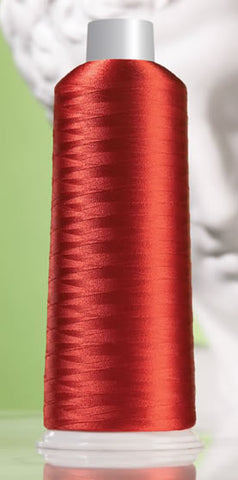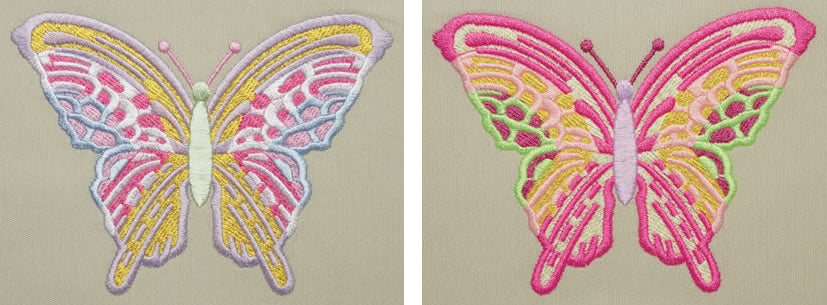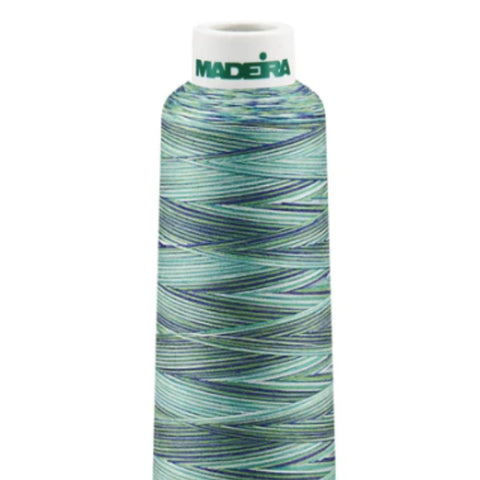Polyester vs. Rayon: What's The Best Embroidery Thread To Use?
Rayon vs. polyester: You need both
By: Alice Wolf
Printwear Magazine
The Embroidery-Thread Challenge is on to help you understand the difference between rayon and polyester! In this corner, weighing in at 135 X 2 dtex*, is the worldwide reigning champion, 100 percent viscose, Top-Quality Rayon. And in this corner, also weighing 135 X 2 dtex, is the challenger from the United States, 100 percent polyester, Top-Quality Poly.
Round One
Whether you choose to wage a fight to the finish, or simply opt for your or your clients’ personal preference, knowing the specific properties of these two general-use embroidery threads will help you anticipate their results. Look what happens when the gloves go on:

“I absolutely prefer rayon,” begins Pat Williams, custom-contract digitizer and owner of Arizona-based Image Embroidery. “The luster and shine provided by rayon is and should be the standard for quality embroidery. Though great attempts have been made to make poly shine, I think they leave the thread with a plastic look.”
And then there’s Tom Moore, dubbed a master digitizer by Printwear in the ‘90s, author, educator and principle of Strawberry Stitch Company in St. Louis: “I have always heard the sheen of rayon is superior to polyester. However, I chuckle that forty-three of our forty-five design awards have been created in polyester and often noted for their vibrant color blends! This has taught me that it is as much what you do with the thread as it is what type of thread is used.”
Rich Medcraft, a full service commercial embroiderer, contract digitizer and owner of StitchWise Embroidery Design in Vancouver, weighs in: “I use both polyester and rayon, depending upon the design and garment. However, my thread of choice is rayon. While polyester thread has its merits, in my opinion there is no comparison in the natural luster and beauty of rayon. It has a natural shine that I have yet to see any polyester match. Designs where I have used polyester have an unrealistic shine, almost like theyare covered in cellophane. Rayon, by, contrast has a subtle sheen which I think creates amazing depth in embroidery.”
Williams draws attention to the added value that embroidery brings to products in the decorated-apparel market, with the reminder: “Since embroidery lends a perceived higher value to the garments that we sew, I can’t see the benefit of using anything but the best. Rayon also gives a nicer hand to the embroidered garment, where I think poly feels heavier and stiffer. For the custom embroiderer, I recommend the use of rayon thread.”

In terms of performance and sheen, there are marked differences between polyester and rayon embroidery thread -- still more argument for selecting the product that best supports the project at hand rather than the one you may like better.
Round Two
Sounds like a no-brainer, doesn’t it? But Moore steps to a neutral corner, pointing out the difficulty in relying too heavily on one’s personal preference: “Discussing thread-type preferences in the embroidery industry can be more difficult than a heated discussion of religion or politics.
It seems, as humans, we are most comfortable with what we were taught or what we have ‘always used.’ I accept the fact that there are valid reasons for using both rayon and polyester, or the thread manufactures wouldn’t expend the time and money on developing and offering both.
“Historically, rayon was the thread of choice as embroidery was reserved for fashion wear and home décor. As the demand for embroidery on outerwear, sporting goods and corporate wear increased, a more durable thread such as poly came into favor. Today, I still look at the roots of thread to determine which of the two I intend to use on a project. Since ninety percent of what we do requires durability to include casual washing practices, I lean towards polyester.”
Ah, there’s the rub. When it comes to commercial laundering, or swimsuits that will spend much of their time in chlorinated water, all will agree: A good quality 100 percent polyester is the workhorse for the job. Even Williams, dubbed “The Rayon Queen” at a recent industry gathering, concedes: “The only time I use poly is on chef’s coats and other white uniforms that may be subjected to commercial laundering. If the embroidery company is a uniform company they would probably be interested in poly threads.”
Medcraft, our contender from the Pacific Northwest concurs: “While the colorfast quality of polyester is desirable, ninety-eight percent of the garments I sell are never exposed to bleach or they would be ruined, regardless of the embroidery thread used. I only use polyester thread on garments that I know will be subjected to commercial laundering.”
No slouch when it comes to washing, a good rayon will stand up to water temperatures of more than 200°F.
Round Three
And then there is the issue of softness. . . not only to the skin, but to the working parts of your embroidery machine. Not one to miss a beat on this count, Williams points out,

While rayon maintains its soft hand even when stitch counts are high, if the target garment is destined for bleach or the commercial laundry, polyester would be the better choice.
“I think that the tie-offs behind the embroidered garment can actually be irritating to the skin when poly thread is used.” Considered the most flexible of embroidery threads due to its softness and pliability, rayon can be stitched out in any direction and will lie flat and not cause any thread looping.
Less abrasive than polyester thread, it is gentle to embroidery equipment. Medcraft concludes: “I prefer rayon simply because it runs better on my machines. Tension settings are constant and smooth and require lighter settings. Polyester requires much tighter tension settings, which are often erratic.”
From the opposite corner of the ring, Moore suggests: “Along with its durability, polyester is more forgiving, causing fewer thread breaks because of its elastic properties. A poorly tensioned machine won’t experience the thread breaks it might if rayon were being used.
This can be a good thing; however it is often abused if the tensions are too far off. When tensions are too tight, polyester thread is stretched as it is being applied. Over time the thread attempts to retract back to its normal state and contributes to puckering. This situation is often misdiagnosed as a digitizing problem, where it quite possibly may be a machine tension deficiency.”
Not to be outdone, rayon’s tensile strength is known worldwide, with the majority of the market choosing rayon for its strength and durability, guaranteeing little to no thread breaks, and its lustrous appearance. In summarizing not only his own approach to the professional decision of which thread to stock up on, but also recommending the most logical one for the industry, Moore concludes: “The percentage of times that I reach for polyester has less to do with my personal preference than it does with the project at hand.
Selecting a quality brand of thread and a type that meets the project’s needs is more important than an embroiderer’s personal preference.
Conclusion
In the embroidery industry knowing what embroidery thread to use for which project is contingent upon a variety of factors and preferences. It will depend on the fabric that you intend on using, the outcome that you desire, and the particular style you are looking to achieve. With this information at your disposal, you can make your creation colorful, decorated, and innovative creations.
Whether you are a larger well known brand or you are a beginner to machine embroidery - being informed and getting the complete details is crucial. We always encourage you to do as much research as possible.
Just the facts:
Advantages of Rayon
- Maintains its soft hand when the stitch count is high, keeping a balance between embroidery and fabric.
- Available in largest selection of weights, fulfilling all embroidery needs: general use, small lettering, economical fill, serging and special effects.
- Silky sheen and softness provide multi-directional embroidery with no looping.
- Least abrasive to embroidery machines, assuring less daily wear and tear to equipment.
- Excellent washing and dry-cleaning properties; can be laundered in water up to 203°F.
Advantages of Polyester
- Bleach resistant and tolerant of harsh chemicals, it will hold up for workwear, uniforms and linens that are commercially laundered.
- Where cost is a factor, polyester is the less expensive thread.
- Poly offers great tensile strength.
- Excellent choice for swimwear which will be exposed to chlorine for prolonged lengths of time.
*Weighing in...
Dtex (decitex), is a universal thread-numbering system that expresses the weight of 10,000 meters of thread in grams. Dtex X 2 refers to two-ply thread. In the U.S., denier (den) is also used to give the weight by measurement of thread length, or the weight in grams of 9,000 meters of thread. Den X 2 also refers to two-ply thread. One denier = 1.111 decitex.
 Alice Wolf is the marketing communications manager for Madeira USA. Her marketing expertise developed through accomplishments in publishing, public relations and sales within the fields of art, home decor, film and television production
Alice Wolf is the marketing communications manager for Madeira USA. Her marketing expertise developed through accomplishments in publishing, public relations and sales within the fields of art, home decor, film and television production
